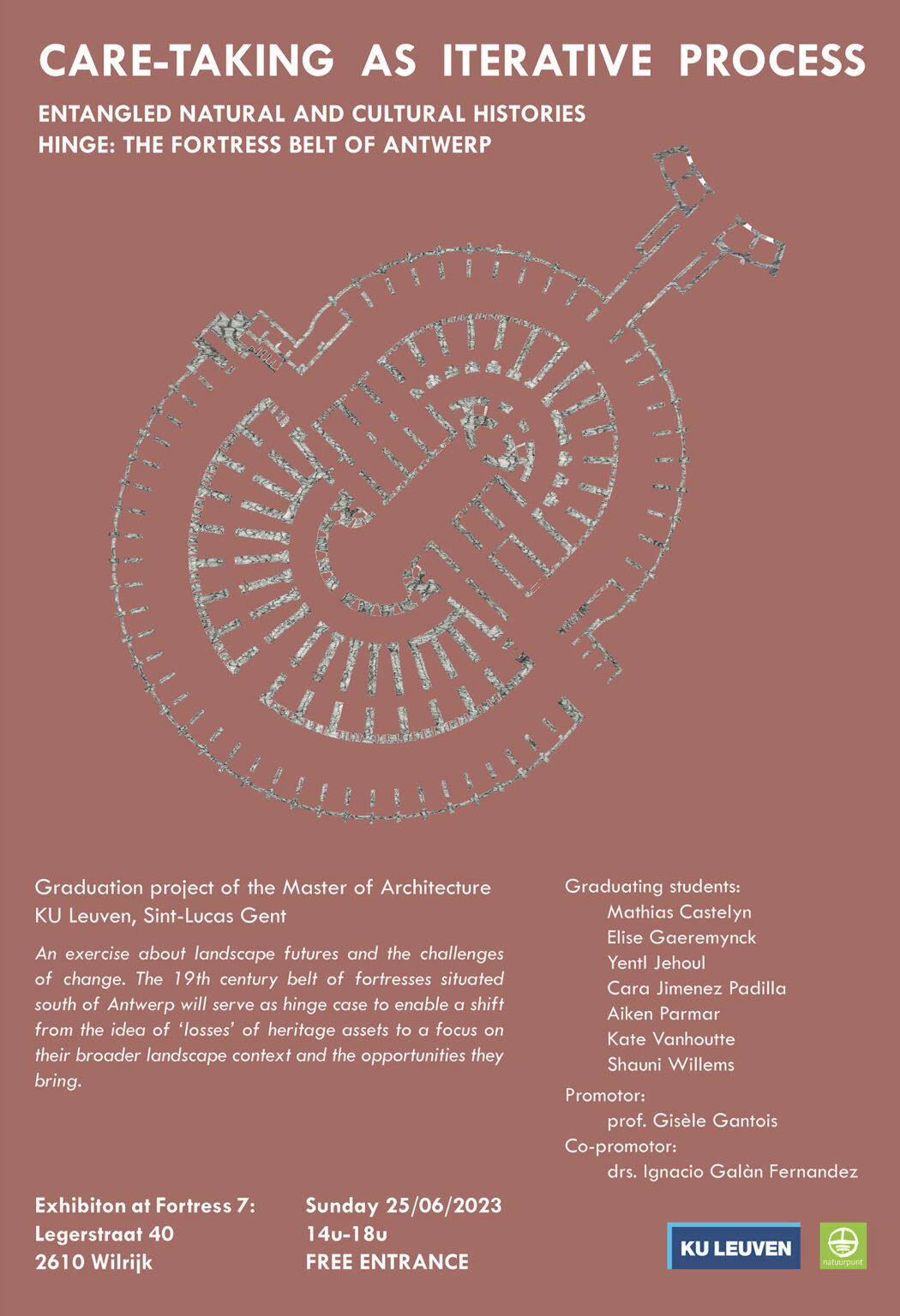CARE-TAKING AS ITERATIVE PROCESS
ENTANGLED NATURAL AND CULTURAL HISTORIES – HINGE: THE FORTRESS BELT OF ANTWERP
Master dissertation studio 2022-23
Supervisor: Gisèle Gantois
Campus: Ghent
Language: EN
Description of the project:
This exercise is about landscape futures and the challenges of change. Therefore, the 19th century belt of fortresses situated south of Antwerp will serve as hinge case to enable a shift from the idea of ‘losses’ of heritage assets to a focus on their broader landscape context.
The belt of fortresses is not only interesting from a historical and (urban) spatial point of view, but also from an ecological point of view as together they house the largest bat population from Europe.
In this exercise we will focus on understanding change in individual fortresses as linked to wider patterns and processes of change and continuity in the landscape while being attentive to how these processes of change can result in both enhanced opportunities for understanding emergent natural/cultural heritage value and significance and distortion of valuable biotopes.
We will work across natural and historic environment areas of expertise and regulation to identify opportunities for integrated management and interpretation of this fortress belt.
We will think about historical characteristics, intrinsic qualities and actual significances, translated in caretaking as iterative process and the importance of no longer studying the buildings as isolated historical artefacts but in relation to both the landscape and each other.
This exercise will be organised in close collaboration with local administrations, Onroerend Erfgoed, Natuurpunt etc. To support this exercise different lectures will be organised. The basis of this real-life case is intense fieldwork with the Interactive Walking method developed by the author (G.G.).
This exercise must be situated within the ADO Restoring Broken Journeys (#5) and within the Engagement Legacy
Link to former ADO exercises #1 and #2 (2022/#3 is under construction)
2022/#2 Church ain’t out ‘til they quit singing. Hinge: Saint-Joseph Church Hellegat
https://issuu.com/restoringbrokenjourneys1/docs/hellegat_2_2022_04_08
2021/#1 Leaf is Tree and Tree is Leaf, House is City and City is House…Case Hellegat
https://issuu.com/restoringbrokenjourneys1/docs/hellegat1_2022_04_08
Key words: Change, Opportunity, Care -Taking, Natural and Cultural Heritage Value, Natural and Cultural Heritage Significance
Expected output: each student will critically define his/her research questions in a designerly way. This will finally result in a design proposal supported by the master dissertation (book). The design research starts from the first observational sketch made on location as part of a proposed three steps methodology of Interactive Walking to enable the student to immerse into the given study area. The detection and implementation of multiple narratives, old and new, graphically recorded through casual and organized encounters, is encouraged. This studio concentrates on (handmade) drawings and tactile models as Interactive Journeys, Spatial Narratives and Cartes Parlantes.
References/Further reading: The research by design is supported by literature research. An initial list of references is included in this file but will be expanded during the design process related to each student’s own individual interests.
Altman, I., and Low, S. (1992) Place attachment: A conceptual inquiry. New York: Plenum Press
DeSilvey Caitlin, 2017. Curated Decay. Heritage beyond saving. Minneapolis and London: University of Minnesota Press: p. 13
Gantois, G. (2021) Built Heritage as Imagines Agentes. In Collabra: Psychology research nexus on The Psychology of Senescent Environments – Environmental Psychology and the Historic Environments https://doi.org/10.1525/collabra.21194
Gantois Gisèle, 2022. ‘A rambling field role for the heritage practitioner: A means to come to more socially sustainable heritage (re-) development projects’ in Fouseki Kalliopi, Cassar May, Dreyfuss Guillaume, Ang Kah-Eng Kelvin (eds), Routledge Handbook of Sustainable Heritage. New York, Routledge
Ingold Tim, and Lee Vergunst Jo, 2008. ‘Introduction in ways of walking: ethnography and practice on foot’ in Anthropological Studies of Creativity and Perception. England: Surrey Ashgate: pp. 1–19
National Trust 2017. Places That Make Us, UK: Walnut Unlimited. Available at: https://nt.global.ssl.fastly.net/documents/places-that-make-us-research-report.pdf
National Trust 2019. Why Places Matter to People, UK: Walnut Unlimited. Available at: https://nt.global.ssl.fastly.net/documents/places-matter-research-report.pdf
Solnit, Rebecca, 2000. Wanderlust: a history of walking. New York, Pinquin Books: p. 162-163
UN, 2020. Intergovernmental panel on climate change report. Available at: https://www.ipcc.ch/ar6-syr/
UN, 2020. Sustainable Development Goals. Available at: https://www.un.org/sustainabledevelopment/development-agenda/
UNESCO, 2011. HUL (Historic Urban Landscape Recommendation). Available at: https://whc.unesco.org/en/hul/
Waterton Emma and Smith Laurajane, 2010. ‘The Recognition and Misrecognition of Community Heritage.’ in International Journal of Heritage Studies, vol. 16, no.1-2: pp. 7-10


